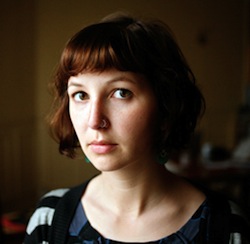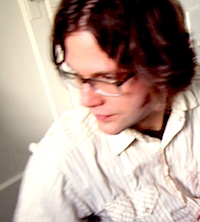
| Jacket 40 — Late 2010 | Jacket 40 Contents | Jacket Homepage | Search Jacket |
This piece is about 4 printed pages long.
It is copyright © Drew Dillhunt and Jacket magazine 2010. See our [»»] Copyright notice.
The Internet address of this page is http://jacketmagazine.com/40/r-obrien-rb-dillhunt.shtml
Sarah O’Brien
Catch Light
reviewed by
Drew Dillhunt
Coffee House Press. Paper. 88 pp. US 16. 978 156689 237 7

Sarah O’Brien
1
Catch Light, Sarah O’Brien’s first full-length book of poetry, explores the often muddled relationship between subjective perception and objective reality. The collection creates communion between the relative and the absolute by fixing on the methodology of documentation as its point of entry. In these poems, the act of interpretation, the moment where ‘the camera reframes its fiction,’ becomes a working definition of beauty (23). By prizing process over product, O’Brien embraces the inherent relativity of empiricism without landsliding into nihilism. Even as she details the tenuous, error-prone link that marks the connection between our isolated consciousnesses and the physical domain our bodies occupy, O’Brien revels in the relentless human drive to fashion this muffled set of signals into a reasonable approximation of the world.
2
In order to point us towards this increasingly relativistic interpretation of events, O’Brien deploys a metaphoric company of ‘doctors running around with bags of glass / eyes in every possible iris’ (47). Each line, each stanza, each section suggests a new lens, a new iris pulled from the bag to examine the data stream. Here, it is the indefatigable drive to propose perspective — rather than absolute truth — that defines the ethos of reality. ‘Even when there’s nothing to see,’ writes O’Brien in the opening poem of the book’s fourth section, Five Eyes, ‘we’d still like the possibility of seeing it’ (47).
3
It is this stance, which is far more interested in potential than particulars, that drives the poetry of Catch Light. O’Brien emphasizes the relativity of perspective through a combined array of windows (to filter light, to frame it) and faces (to collect light, to fix it). Without a window to frame the scene, the face is overwhelmed by the magnitude of the possible; without the face, documentation ceases to insist. These faces struggle to commune with windows, to make sense of the brief glimpses that are offered. There is a pervasive sense of memory as a haunting, of a ghost face headed in the other direction:
4
Someone passes a picture window and sees the face clearly for a split second but still after it is down the road out of sight what is that seeing called. (43)
5
It is the fleeting substance of such memories that we so desperately want to communicate, by preserving the light that initiates them. This desire to fix the present moment, to embalm the reality of our own fragility, these poems suggest, provides the impetus — both as individuals and as a species — to drive the act of documentation.
6
‘We think burn, etch, ingrain,’ O’Brien intones in ‘The Camera Lens,’ ‘Imagine a sear and a sound imperceptible but still. The sound it takes to stay’ (77). At its most basic, documentation is the active production of corporeal memory, which, accurate or not, can be examined and interpreted by an individual other than the originator. While perception occurs constantly (and unconsciously) in the context of an individual mind, the production of a document can occur only as an intentioned act.
7
Given the inherent fallibility of memory, and thus any document produced from it, Catch Light rightly poses the question, ‘should we bother / drawing pictures of light?’ (50). O’Brien’s response to this inquiry is a resounding, lyrical affirmative. ‘Images do not stick to windows,’ she writes, ‘Light must be bent, to return, come back’ (77). Here, the concept of ‘photograph’ is never limited to the process of a camera collecting a picture, but instead refers to any attempt to collect information and make sense of it. We have ‘many ways of saying: / this is the last look from the last face on earth’ (57). The modern photograph is simply the most recent development in an extended string of optical-mnemonic inventions beginning with the window (which was ‘more obvious than the camera’) (75).
8
In his collection Mute Objects of Expression, the French poet Francis Ponge defines a poet as one who ‘separates the qualities of the object then recomposes them’ (28), a description that O’Brien openly embraces. To reconstitute reality through the filter of perception, these poems insist, is to be human; we are all interpreters of sensation in the midst of creating ‘whole histories of keep’ (75).
9
While the poetics of phenomenology serve as a starting block for her collection, O’Brien inquires if the experiment can be taken a step further. She employs a communal buildup of successive documentations — of the very sort described by Ponge — in an effort to transcend quality, if only briefly. Where Ponge uses revision as a tool to whittle down to the essential, O’Brien stockpiles these revisions, made available through the relativity of perspective, and asks if the essential can be overwhelmed.
10
O’Brien’s careful economy of words, and use of space on the page, helps to initiate this dissolve — a fade to white that occurs when sustained focus locates the place where ‘light goes / illegible’ (23):
11
and you recite it because you know how. This is
how you learned. While the habitat here sometimes teems
we are sorry, closed, etc. The through in it reaches past the
sentence. Do you even know what you’re seeing? (48)
12
The linear narrative of O’Brien’s poetry evanesces and then reappears, often within in the same stanza. Even as these poems keep one hand firmly in the world of objects, the other flails freely in the void asking each of us to fill the gaps — both literal and metaphoric — from our own perspective.
13
The refined subtly of these poems contains an epic energy that shivers like atomic orbitals just beneath the surface and results in eventual flashbulb blow outs. From the moment the collection unveils its haunting twin epigraphs, Catch Light works to systematically focus our attention on a serpentine continuum which begins (continues) with the quotidian act of documentation and concludes (resets) with transcendent overexposure. O’Brien depicts a world in which we’re all going blind to see; where we collect damaged data in order to overwhelm it, to reconstruct our vision.
14
The force of will that drives the repetition of a futile act is ‘a system based on the subtlest of difference. A test, the surface of a shell’ (79). O’Brien is not troubled by the notion of documentation as a reflexive, defensive, and ultimately futile bid to preserve an instant already ‘dead like a second’ (79). Hers is a methodical and yet deeply human approach to transcendence, which prizes the act of documentation not in spite of its futility, but because of it. These poems insist that only through the progressive overlay of such captures can verity be glimpsed.
Ponge, Francis. Mute Objects of Expression. Trans. Lee Fahnestock. New York: Archipelago, 2008.

Drew Dillhunt
Drew Dillhunt lives in the Beacon Hill neighborhood of Seattle and is co-author, with his father, CX, of the chapbook Double Six (Endeavor, 1994). His writing has appeared in Hummingbird: Magazine of the Short Poem, The Pitkin Review, and Tarpaulin Sky. He’s the author of the poetry manuscript Materials Science, which was selected as a finalist for the National Poetry Series 2009 Open Competition. He has released two albums of his songs, including one with the band Fighting Shy.